A high-quality receiver isn’t just a convenient way to control your entire entertainment system with one remote. The right receiver maintains or even enhances the quality of your content, and gives you the power to fine-tune your speakers to match the acoustics of your space.
We considered a variety of factors in our search for the best 9.2 receiver. The Yamaha RX-A6A is the overall winner, with a straightforward guided setup, excellent sound quality, and smooth smart home integration. That’s not to say it’s the best choice for everybody, though. Let’s look at some of the key features so you can decide which receiver is right for you.
Best 9.2 Receiver 2023 – Top picks:
| Denon AVR-X3700H | Denon AVR-X4700H | Onkyo TX-NR7100 | Marantz SR6015 | Onkyo TX-RZ50 | Yamaha RX-A6A | |
|---|---|---|---|---|---|---|
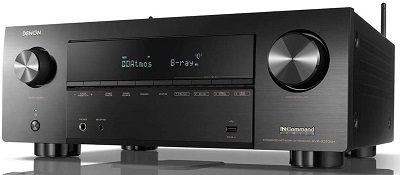 | 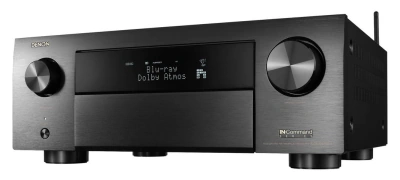 | 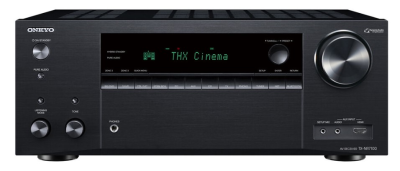 | 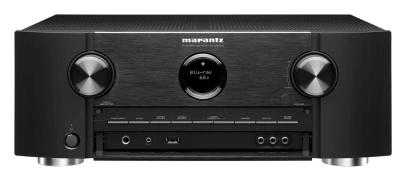 | 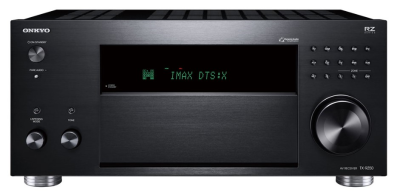 |  |
|
| Video | 8K/60Hz, 4K/120Hz | 8K/60Hz, 4K/120Hz | 8K/60Hz, 4K/120Hz | 8K/60Hz, 4K/120Hz | 8K/60Hz, 4K/120Hz | 8K/60Hz, 4K/120Hz |
| Amplifier | 9.2 Channel (105 Watt X 9) | 9.2 Channel (200W per channel) | 9.2 channel (220W per channel) | 9.2 Channel (110W per channel) | 9.2 channel (120W per channel) | 9.2 channel (150W per channel) |
| Sound | 7.1.2, 5.1.4 or 2.1 Dolby Atmos | 7.2.4 or 9.2.2 Dolby Atmos | 7.2.2 or 5.2.4 Dolby Atmos | Dolby Atmos, DTS:X | 11.2 or 7.2.4 Dolby Atmos | 11.2 or 9.2 Dolby Atmos |
| Wi-Fi | Yes | Yes | Yes | No | Yes | Yes |
| Bluetooth | Yes | Yes | Yes | No | Yes | Yes |
| Price | Find on Amazon | Find on Amazon | Find on Amazon | Find on Amazon ProjectorScreen.com | Find on Amazon B&HPhotoVideo | Find on Amazon B&HPhotoVideo |
Home Theater Use
For a home theater, you want a receiver that will maintain the contrast, color, and detail of the video signal. All of these receivers have at least a 4K pass-through, while many go a step further and support 8K video resolutions. The Marantz SR6015 is the best in this regard, with 8K upscaling on all HDMI ports as well as support for visual technology like HDR10 and HLG. The Onkyo TX-RZ50 comes in a close second, with full 8K support on all HDMI ports, though it lacks the upscaling you’ll get from the Marantz.
Sound quality is just as crucial for a truly immersive home theater experience. Every receiver reviewed here supports 3D surround sound and can deliver a powerful, detailed sonic picture. Here, it’s the Yamaha RX-A6A that takes the slight edge thanks to its extensive sound calibration and room optimization functions, including AI-guided sound analysis and Cinema DSP sound field creation.
Best home theater picture: Marantz SR6015
Best home theater sound: Yamaha RX-A6A
Gaming Performance
The same picture and sound considerations for home theater apply for gamers, but there’s another crucial factor to consider: the lag time. Some receivers add delay to the signal, and this can be a problem for reflex-based gaming.
If you plan to connect a PC or gaming console to the receiver, look for one that offers Variable Refresh Rate (VRR) and Auto Low Latency Mode (ALLM). You’ll get both of these from Denon receivers like the AVR-X4700H and AVR-X3700H, along with a 4K/120Hz pass-through that ensures a smooth playing experience for all kinds of games.
Best gaming performance: Denon AVR-X3700H, Denon AVR-X4700H
Power and Volume
If you have a larger home theater space, you need more power from your receiver to fill the room with sound. All of these receivers are powered by at least 110 watts per channel, but the Onkyo TX-NR7100 takes the cake when it comes to sheer power, with 220 watts per channel. This means big, full sound for any space and speakers.
Most powerful receiver: Onkyo TX-NR7100
Smart Home and Wireless Control
All of these receivers have at least some voice control capability through a service like Alexa or Google Assistant. They don’t all offer the same array of command options, however, and some only support voice searches and basic playback commands.
The variety of wireless control options on the Yamaha RX-A6A make it the top choice for smart home owners on the list. While you will need a third-party speaker to use voice control, it has a robust array of commands for the major providers. It also works with apps like AirPlay 2 and MusicCast for controlling the receiver through your phone, expanding your options for how to control playback of your content.
Best for smart homes: Yamaha RX-A6A
Setup Ease
With their plethora of inputs and options, A/V receivers can be a bit intimidating for first-time users. Receivers that have a guided installation and calibration system take the trial and error out of the set-up process, an especially helpful tool for home theater beginners.
The automatic room calibration of the Yamaha RX-A6A is a handy feature in this regard, providing optimized sound without the need for manual fiddling. The Denon X3700H and X4700H expand on this with a fully guided on-screen setup assistant that streamlines the installation process.
Easiest to set up: Denon AVR-X3700H, Denon AVR-X4700H
Denon AVR-X3700H

The Denon AVR-X3700H is an excellent all-purpose receiver for controlling all the entertainment in your home. It’s an ideal choice for home theaters and media rooms, supporting video resolutions up to 8K, backed by technology like HDR10+ that keeps that picture sharp and vibrant. Gamers can use it, too, with a fast 120Hz frame rate in 4K and the technology you need for a smooth playing experience, free of lag or frame tearing.
Another point in the Denon AVR-X3700H’s favor is how easy it is to set up and use. The large display and intuitive controls make it easy to adjust inputs and settings, while the guided set-up assistant walks users through the process of connecting and calibrating speakers.
For smart home users, the Denon AVR-X3700H supports a variety of voice control services, as well as home automation services like Josh.ai. You can also control speakers and content wirelessly through HEOS or AirPlay, along with its direct streaming capabilities. All of these features combine to make it a top choice for modern home theaters.
Pros
- 3D audio with a variety of speaker configurations
- Supports video content up to 8K
- 4K pass-through and upscaling
- Lag-free gaming with VRR and ALLM
- Easy installation with on-screen setup assistant
- Streams music from Pandora, TuneIn, and other services
- Multi-room music through HEOS
Cons
- 4K pass-through not supported from all media sources
Denon AVR-X4700H
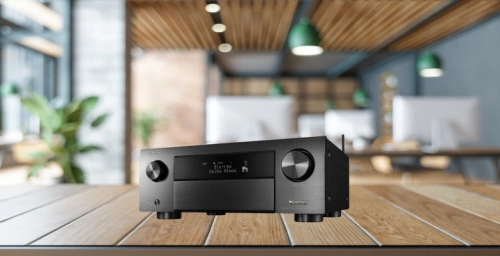
The Denon AVR-X4700H shares a lot of strengths with the 3700H above. It’s just as easy to set up, for one thing, with a similar guided set-up assistant and two calibration pre-sets to choose from for the speakers. It’s also equally well-designed for integration into smart home entertainment systems, supporting HEOS multi-room music and a range of voice control platforms.
The main advantage of the AVR-X4700H is that it’s more powerful. With 125 watts per channel, it can reach higher volume levels without any distortion, letting you enjoy hi-fi music or movie effects at any volume. Dolby Atmos Height Virtualization means you can create fully immersive 3D soundscapes in a home theater.
The Denon AVR-X4700H does an equally great job maintaining the quality of visual signals. It can process 8K content and has a 120Hz pass-through for 4K. That’s good news for gamers as well as home theater use, and it has ALLM and VRR to prevent lag, frame tearing, and other issues from interrupting your play. Click here for our more in-depth Denon AVR-X4700H review.
Pros
- 8K ready
- Lag-free 4K gaming
- Full 3D sound support
- Powerful volume output
- Wide voice control compatibility
- Easy to use set-up assistant
- Extensive wired and wireless connectivity
Cons
- May be too large for some entertainment centers
- Pass-through not supported for all media sources
Onkyo TX-NR7100
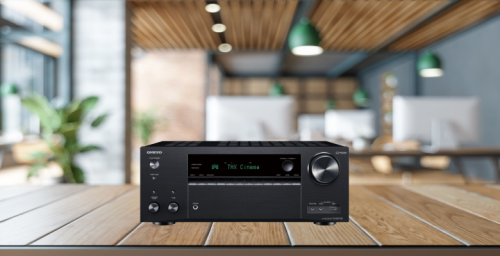
The Onkyo TX-NR7100 is the first 9-channel receiver in the company’s line to include built-in DIRAC Live Room Correction. This allows you to calibrate the sound to your space automatically through their connected app. The TX-NR7100 makes it easy to get high-quality sound in other ways, too, with THX Certified sound and a powerful 220 watts per channel, as well as DTS Play-Fi for music.
The connectivity of the Onkyo TX-NR7100 makes it a flexible choice for whole-home entertainment. It supports both bi-directional Bluetooth and Wi-Fi, letting users wirelessly cast content through Chromecast or stream directly through services like TuneIn, Pandora, and Spotify. Zone 3 HDMI switching means you can set up two full entertainment spaces, including 8K displays in each.
The Onkyo TX-NR7100 equally flexible when it comes to the 3D sound within a home theater, supporting multiple speaker configurations as well as Dolby Atmos Height Virtualization, DTS:X, DTS Virtual:X, and IMAX Enhanced content. For gamers, lag-reduction technology like ALLM , VRR, and QFT ensures a smooth playing experience with no added delays.
Pros
- Powerful THX-certified 3D sound
- Video resolutions up to 8K
- Automatic room correction with DIRAC
- Full 2-zone capability, including displays
- Good choice for gaming
- Easy integration into Google and Alexa smart home systems
Cons
- No built-in microphone (requires 3rd party device for voice control)
Marantz SR6015
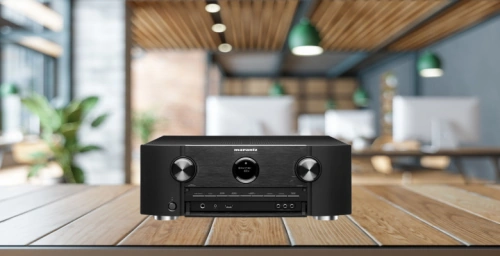
If the SR7015 is a bit out of your budget range, the Marantz SR6015 has a lot of the same features and usually sells for a few hundred dollars less, making it a great value for A/V enthusiasts. This includes 8K upscaling on all 7 HDMI ports, as well as advanced object-based audio formats like IMAX Enhanced and Dolby Atmos Height Virtualization for 3D sound.
The Marantz SR6015 produces a sound quality to suit any audiophile. Each channel uses a discrete amplifier powered by 110 watts—not the most on the list, but enough for a full, detailed sound from any source. Support for HEOS is built-in, too, so you can control the music throughout your home right from the SR6015.
Like other Marantz receivers, the SR6015 works with the 3 major voice control systems, but doesn’t work as well with other home automation systems. The option of controlling it with the Marantz remote app through a phone or tablet is a helpful feature from an ease of use standpoint, too, as is the direct music streaming through AirPlay. For our more in-depth Marantz SR6015 review, click here.
Pros
- 8K upscaling on all HDMI ports
- Full 3D sound and video support
- Discrete amplifiers for full, clear sound
- Built-in music streaming
- Works with Alexa, Google, and Apple voice control
- Great value
Cons
- Lower maximum output than other models
- Not a great choice for home automation integration
Onkyo TX-RZ50

For large or complicated home theater setups, the Onkyo TX-RZ50 has the features and functionality you need. It can process signals up to 11.2 channels, allowing it to drive 7.2.4-channel 3D sound configurations for a more nuanced and immersive home theater experience. Like with other Onkyo receivers, that sound is THX Certified, and it supports Dolby Atmos, DTS:X, and IMAX Enhanced audio. Four THX listening modes let you further tweak the sound for movies, games, music, or surround sound effects.
It’s also easy to configure the sound from the Onkyo TX-RZ50 to any home theater. It has built-in DIRAC Live Room Correction to ensure a balanced and precise sound across your space, along with integrated streaming and DTS Play-Fi. You can also use it with any brand of speaker. It’s Sonos certified and has a Klipsch Optimize Mode to get the best sound from Reference Premiere speakers. For Atmos-enabled speakers, the AccuReflex phase matching to calibrate the speakers and optimize the synchronized output of object-based audio.
You’ll get that same high quality from video signals played through the Onkyo TX-RZ50. All of its HDMI inputs support 8K resolutions, as well as HDR10+, HLG, and Dolby Vision. For gamers, the high frame refresh rate and lag reducing ALLM keep the on-screen action smooth. It’s also a good choice for smart home owners, with built-in multi-zone streaming and full Zone 2 HDMI switching, as well as easy integration into Apple, Alexa, or Google smart home ecosystems.
Pros
- Processes sound up to 11.2 channels
- Easy sound configuration through DIRAC
- Multiple THX listening modes
- Wireless music streaming and content mirroring
- Works with Sonos, Klipsch, and Atmos-enabled speakers
- Supports 8K resolutions in multi-zone setups
- Low latency for gamers
Cons
- No built-in microphone for voice control
Yamaha RX-A6A
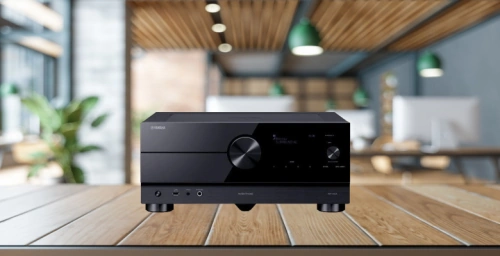
The Yamaha RX-A6A can process signals up to 11.1 channels, with a 9.2-channel high slew rate amplifier that drives speakers with up to 150 watts per channel. This is combined with Yamaha’s sophisticated 3D sound technology, with Cinema DSP sound field creation and Auro-3D to ensure audio signals move naturally through the listening space. To calibrate the sound, it uses Yamaha’s Room Acoustic Optimizer (YPAO) with Reflected Sound Control and a precise 64-bit EQ. AI technology built into the DSP analyzes and optimizes the sound in real-time.
The Yamaha RX-A6A also supports multiple 3D sound formats. This includes Dolby Atmos Height Virtualization as well as setups using physical height speakers in DTS:X or DTS Neural:X formats. You can also use it for whole home entertainment, with Zone 2/3/4 surround sound as well as MusicCast support for multi-room audio. It brings that same quality to video signals, supporting 8K resolutions along with Dolby Vision and HLG to make sure what you see is as lifelike as what you hear.
One thing we love about the Yamaha RX-A6A is how easy it is to control. The four SCENE button presets are programmable, letting you save and quickly switch between the ideal settings for different inputs. It can also be controlled through your phone using the MusicCast app, or by voice control through services like Alexa, Google Assistant, or Siri, provided you have a third-party device with that capability running on the same network. For our more in-depth review of this receiver, follow the link: http://hqsound101.com/yamaha-rx-a6a-review/
Pros
- Multiple 3D sound formats
- 9-channel high slew rate amplifier
- Supports 8K resolutions
- Wide array of multi-room music options
- Automatic sound calibration
- Easy to set up and control
Cons
- No built-in lag reduction (will be added in a future update)
- Higher cost
The Verdict: Best 9.2 Receiver
Your space and equipment are the first things to think about when you’re buying a receiver. For a larger room, the powerful Onkyo TX-NR7100 is an excellent option, while gamers will love the responsiveness of the Denon AVR-X4700. It’s true that the Yamaha RX-A6A is the best all-around option, but each of the receivers reviewed here was picked out for a reason and they all have their strengths (>>> Find on Amazon). We hope this review has helped you see the differences and decide which is the perfect choice for your home!
FAQs
There are two key pieces of information conveyed by the channel number of a receiver. The number before the point tells you how many speaker channels it can process at one time, while the number after the point indicates the number of subwoofer channels. Therefore, a 9.2 channel receiver can process 9 speaker channels and 2 subwoofer channels.
There aren’t any speakers actually built into the receiver. Instead, the receiver just processes the signals, sending them along to the speakers and display. To hear the sound, you’ll still need to connect the receiver to a speaker system or soundbar.